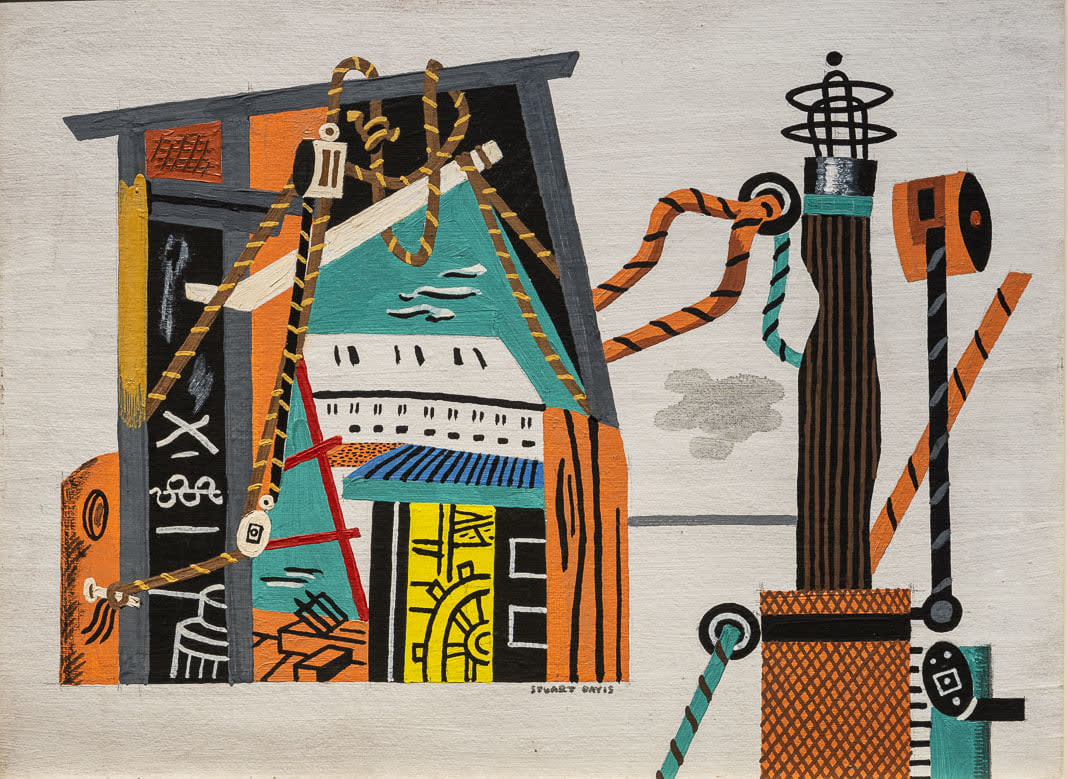-
Stuart Davis American, 1892-1964
Fortap, 1933Oil on panel12 x 16 inches
30.5 x 40.6 cmSigned at lower center: STUART DAVISBorn in Philadelphia, Stuart Davis studied in New York under Robert Henri whose encouragement to depict the variety of contemporary urban life informed Davis’s career. He began experimenting with Pablo...Born in Philadelphia, Stuart Davis studied in New York under Robert Henri whose encouragement to depict the variety of contemporary urban life informed Davis’s career. He began experimenting with Pablo Picasso’s Synthetic Cubism following the Armory Show of 1913, and by the 1920s, created his personal language of abstraction that combines urban street life and images from popular culture. This impulse came to fruition in his famous Egg Beater series of 1920-27 which incorporates household paraphernalia as a metaphor for modern life and marks his earliest foray into pure abstraction. As Karen Wilkin observes, despite Davis’s assertion that the Egg Beater paintings are “the culmination of these efforts,” she adds, “the series by no means exhausted such vernacular household or hardware subjects. In Gloucester [Massachusetts], Davis substituted gasoline pumps for household staples, using them as surrogate figures in his townscapes.”[1] In 1932, Davis retreated to Gloucester, a small fishing town that he first visited in 1915 with his parents at the suggestion of John Sloan. Gloucester’s harbor became a source of inspiration and an important leitmotif in his art. Painted in 1933, Fortap highlights the iconography of harbor life through two separate scenes connected by dangling rope. On the left, a busy assortment of nautical images includes a shed, dock, wheelhouse, and rigging, and on the right, the beacon light stands alone. Davis uses a divided structure to explore formal concerns, offering two scenes with two perspectives inspired by Cubism. According to the Davis catalogue raisonné, the artist assigned the title and date when the Downtown Gallery acquired the painting in 1959. The meaning of “fortap” is unknown but it may be Davis’s misspelling of the nautical term “foretop” which is the platform at the head of a ship’s foremast.[2]
[1] Karen Wilkin in Ani Boyajian and Mark Rutkoski, Stuart Davis: A Catalogue Raisonné, Vol. I (New Haven, Connecticut and London: Yale University Press, 2007), pp. 67-68.
[2] Boyajian, Vol. III, p. 279.
Provenance
The artist;
Mr. and Mrs. Bryan, 1937;
[The Downtown Gallery, New York, 1959];
Edith Gregor Halpert, New York; to
The Patsy R. and Raymond D. Nasher Collection, Dallas, 1969;
[Sale: Sotheby's, New York, May 22, 2008, lot 115];
Richard and Jane Manoogian, Detroit, Michigan;
[Michael Altman Fine Art & Advisory Services, New York]; to
Private collection, until the presentExhibitions
Nordness Gallery, New York, The Importance of the Small Painting, March 28-April 16, 1960, no. 13
The Corcoran Gallery of Art, Washington, D.C., The Edith Gregor Halpert Collection, September 28-November 11, 1962Literature
Ani Boyajian and Mark Rutkoski, Stuart Davis: A Catalogue Raisonné, Vol. III, New Haven and London: Yale University Press, 2007, p. 279, no. 1602, illus.
Subscribe to our mailing list to receive updates from the gallery
* denotes required fields
We will process the personal data you have supplied in accordance with our privacy policy (available on request). You can unsubscribe or change your preferences at any time by clicking the link in our emails.

